APS-401: Current Trends & Applications of AR Glasses in Aviation
VerifiedAdded on 2021/02/20
|14
|5039
|71
Report
AI Summary
This report provides a comprehensive overview of augmented reality (AR) glasses and their applications within the aviation industry, focusing on their impact on aviation maintenance. The report begins with an introduction to the technology, including the use of artificial intelligence (AI) and AR, and then details the specific technologies used in AR glasses, such as Simultaneous Localization and Mapping (SLAM) and computer vision. It examines the benefits of AR glasses, such as providing mechanics with access to real-time data, manuals, and videos, as well as the limitations, including potential discomfort and obstruction of views. The report then traces the origin and evolution of AR technology. The report further delves into the ethical considerations surrounding AR glasses, including privacy and security concerns, as well as potential short and long-term medical issues like eye strain and neurological effects. It also addresses the environmental impacts of AR glasses, focusing on energy consumption and carbon emissions associated with training AI models. Finally, the report explores historical trends and future directions for AR technology in aviation, concluding with a summary of the key findings and implications for the industry.
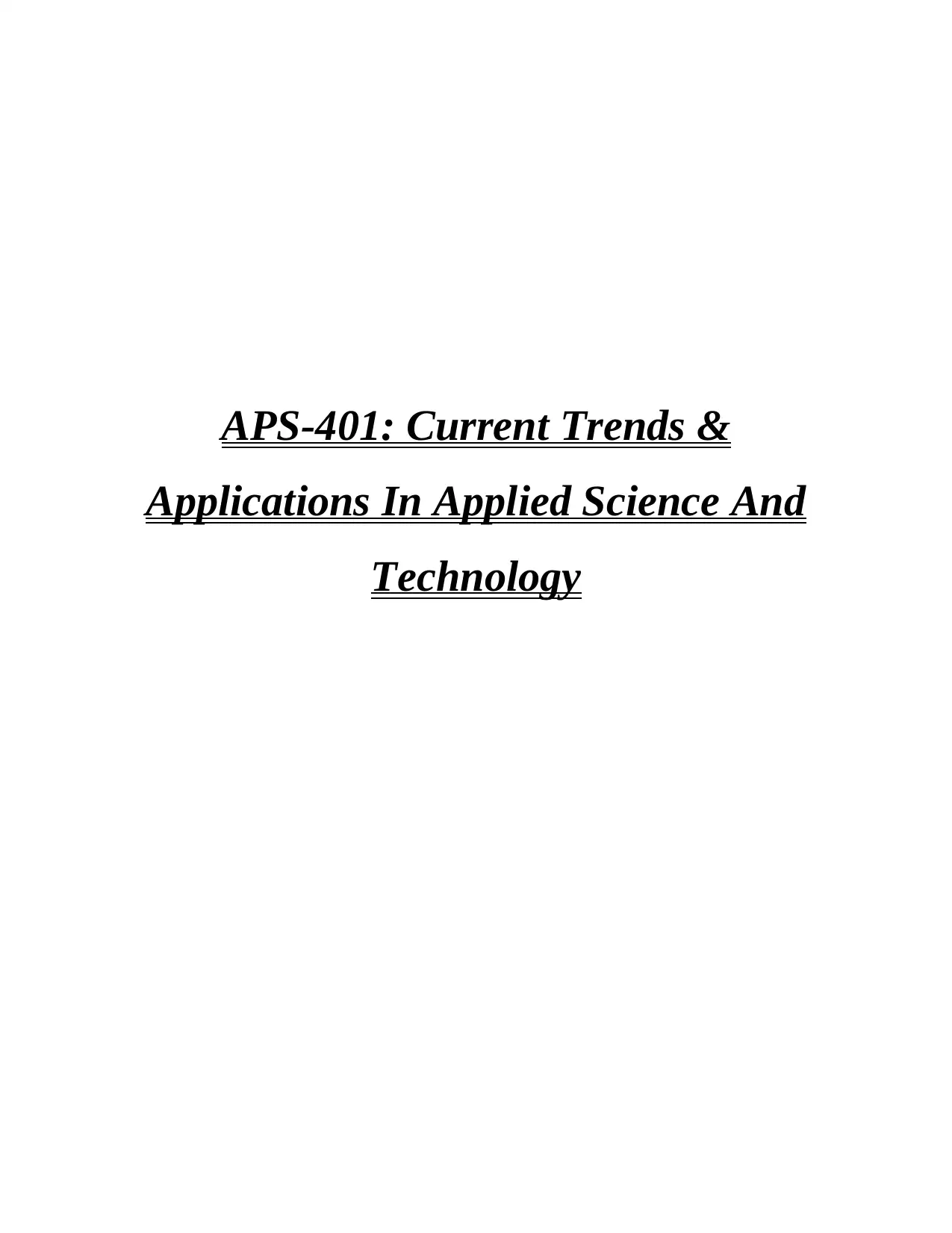
APS-401: Current Trends &
Applications In Applied Science And
Technology
Applications In Applied Science And
Technology
Paraphrase This Document
Need a fresh take? Get an instant paraphrase of this document with our AI Paraphraser
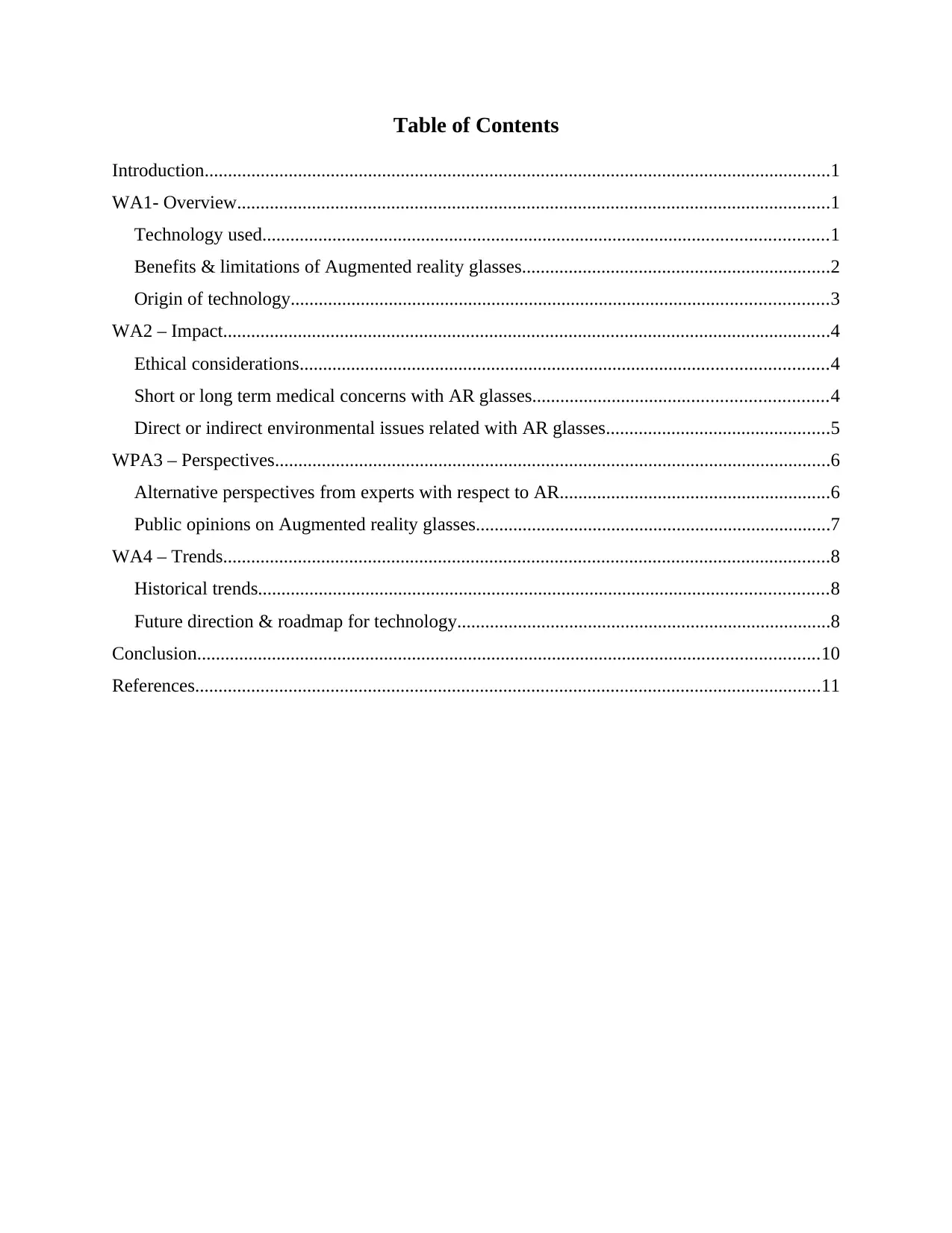
Table of Contents
Introduction......................................................................................................................................1
WA1- Overview...............................................................................................................................1
Technology used.........................................................................................................................1
Benefits & limitations of Augmented reality glasses..................................................................2
Origin of technology...................................................................................................................3
WA2 – Impact..................................................................................................................................4
Ethical considerations.................................................................................................................4
Short or long term medical concerns with AR glasses...............................................................4
Direct or indirect environmental issues related with AR glasses................................................5
WPA3 – Perspectives.......................................................................................................................6
Alternative perspectives from experts with respect to AR..........................................................6
Public opinions on Augmented reality glasses............................................................................7
WA4 – Trends..................................................................................................................................8
Historical trends..........................................................................................................................8
Future direction & roadmap for technology................................................................................8
Conclusion.....................................................................................................................................10
References......................................................................................................................................11
Introduction......................................................................................................................................1
WA1- Overview...............................................................................................................................1
Technology used.........................................................................................................................1
Benefits & limitations of Augmented reality glasses..................................................................2
Origin of technology...................................................................................................................3
WA2 – Impact..................................................................................................................................4
Ethical considerations.................................................................................................................4
Short or long term medical concerns with AR glasses...............................................................4
Direct or indirect environmental issues related with AR glasses................................................5
WPA3 – Perspectives.......................................................................................................................6
Alternative perspectives from experts with respect to AR..........................................................6
Public opinions on Augmented reality glasses............................................................................7
WA4 – Trends..................................................................................................................................8
Historical trends..........................................................................................................................8
Future direction & roadmap for technology................................................................................8
Conclusion.....................................................................................................................................10
References......................................................................................................................................11
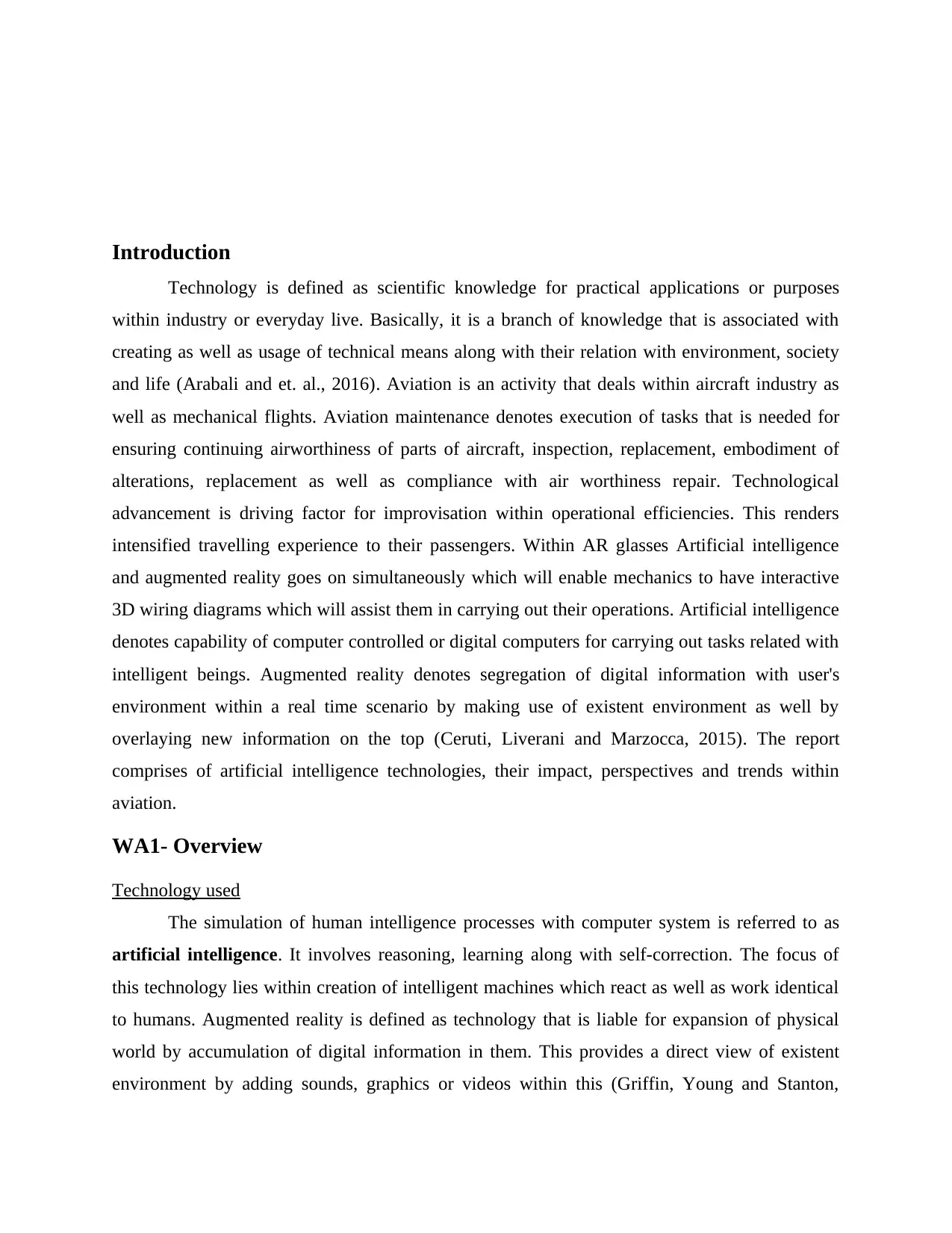
Introduction
Technology is defined as scientific knowledge for practical applications or purposes
within industry or everyday live. Basically, it is a branch of knowledge that is associated with
creating as well as usage of technical means along with their relation with environment, society
and life (Arabali and et. al., 2016). Aviation is an activity that deals within aircraft industry as
well as mechanical flights. Aviation maintenance denotes execution of tasks that is needed for
ensuring continuing airworthiness of parts of aircraft, inspection, replacement, embodiment of
alterations, replacement as well as compliance with air worthiness repair. Technological
advancement is driving factor for improvisation within operational efficiencies. This renders
intensified travelling experience to their passengers. Within AR glasses Artificial intelligence
and augmented reality goes on simultaneously which will enable mechanics to have interactive
3D wiring diagrams which will assist them in carrying out their operations. Artificial intelligence
denotes capability of computer controlled or digital computers for carrying out tasks related with
intelligent beings. Augmented reality denotes segregation of digital information with user's
environment within a real time scenario by making use of existent environment as well by
overlaying new information on the top (Ceruti, Liverani and Marzocca, 2015). The report
comprises of artificial intelligence technologies, their impact, perspectives and trends within
aviation.
WA1- Overview
Technology used
The simulation of human intelligence processes with computer system is referred to as
artificial intelligence. It involves reasoning, learning along with self-correction. The focus of
this technology lies within creation of intelligent machines which react as well as work identical
to humans. Augmented reality is defined as technology that is liable for expansion of physical
world by accumulation of digital information in them. This provides a direct view of existent
environment by adding sounds, graphics or videos within this (Griffin, Young and Stanton,
Technology is defined as scientific knowledge for practical applications or purposes
within industry or everyday live. Basically, it is a branch of knowledge that is associated with
creating as well as usage of technical means along with their relation with environment, society
and life (Arabali and et. al., 2016). Aviation is an activity that deals within aircraft industry as
well as mechanical flights. Aviation maintenance denotes execution of tasks that is needed for
ensuring continuing airworthiness of parts of aircraft, inspection, replacement, embodiment of
alterations, replacement as well as compliance with air worthiness repair. Technological
advancement is driving factor for improvisation within operational efficiencies. This renders
intensified travelling experience to their passengers. Within AR glasses Artificial intelligence
and augmented reality goes on simultaneously which will enable mechanics to have interactive
3D wiring diagrams which will assist them in carrying out their operations. Artificial intelligence
denotes capability of computer controlled or digital computers for carrying out tasks related with
intelligent beings. Augmented reality denotes segregation of digital information with user's
environment within a real time scenario by making use of existent environment as well by
overlaying new information on the top (Ceruti, Liverani and Marzocca, 2015). The report
comprises of artificial intelligence technologies, their impact, perspectives and trends within
aviation.
WA1- Overview
Technology used
The simulation of human intelligence processes with computer system is referred to as
artificial intelligence. It involves reasoning, learning along with self-correction. The focus of
this technology lies within creation of intelligent machines which react as well as work identical
to humans. Augmented reality is defined as technology that is liable for expansion of physical
world by accumulation of digital information in them. This provides a direct view of existent
environment by adding sounds, graphics or videos within this (Griffin, Young and Stanton,
⊘ This is a preview!⊘
Do you want full access?
Subscribe today to unlock all pages.

Trusted by 1+ million students worldwide
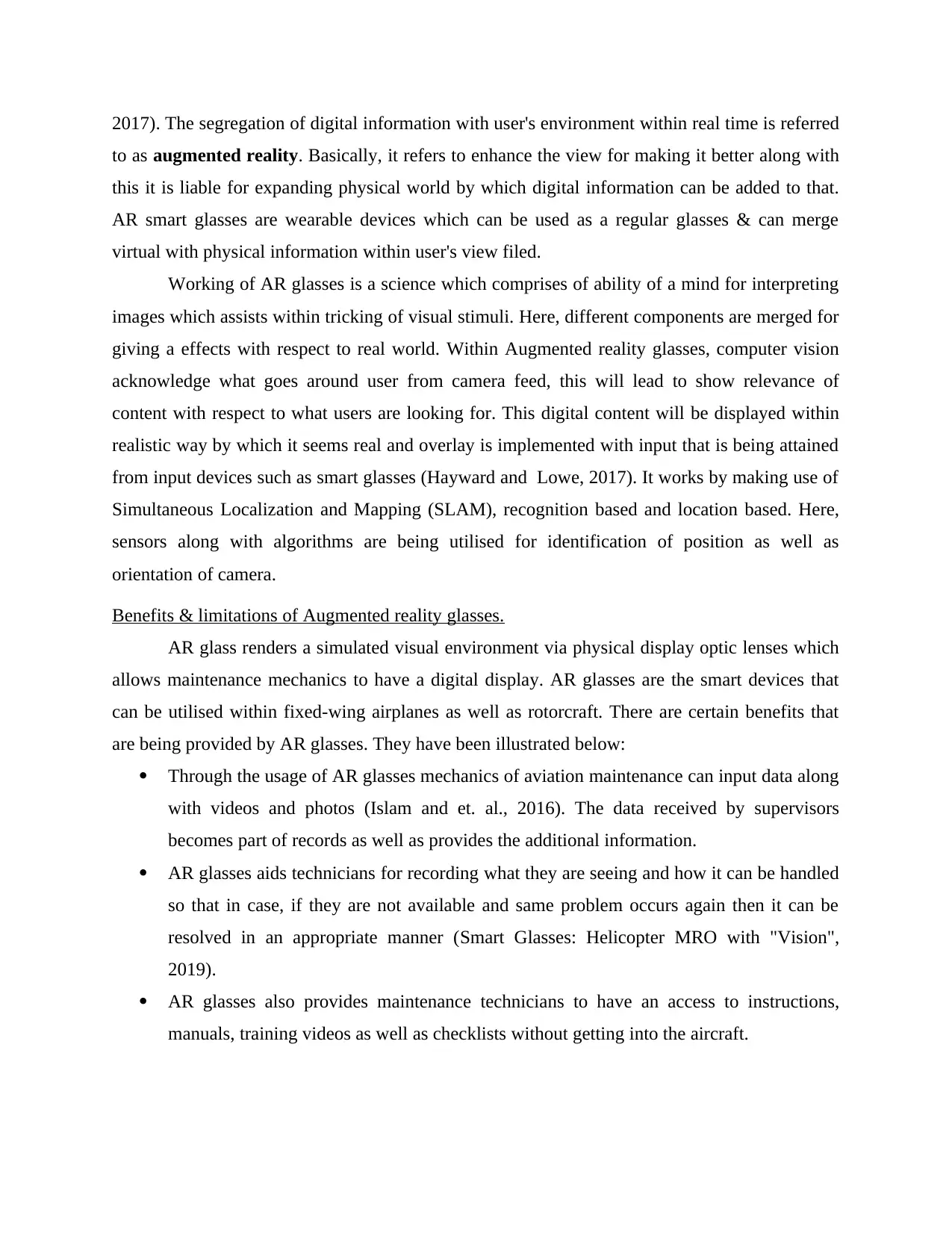
2017). The segregation of digital information with user's environment within real time is referred
to as augmented reality. Basically, it refers to enhance the view for making it better along with
this it is liable for expanding physical world by which digital information can be added to that.
AR smart glasses are wearable devices which can be used as a regular glasses & can merge
virtual with physical information within user's view filed.
Working of AR glasses is a science which comprises of ability of a mind for interpreting
images which assists within tricking of visual stimuli. Here, different components are merged for
giving a effects with respect to real world. Within Augmented reality glasses, computer vision
acknowledge what goes around user from camera feed, this will lead to show relevance of
content with respect to what users are looking for. This digital content will be displayed within
realistic way by which it seems real and overlay is implemented with input that is being attained
from input devices such as smart glasses (Hayward and Lowe, 2017). It works by making use of
Simultaneous Localization and Mapping (SLAM), recognition based and location based. Here,
sensors along with algorithms are being utilised for identification of position as well as
orientation of camera.
Benefits & limitations of Augmented reality glasses.
AR glass renders a simulated visual environment via physical display optic lenses which
allows maintenance mechanics to have a digital display. AR glasses are the smart devices that
can be utilised within fixed-wing airplanes as well as rotorcraft. There are certain benefits that
are being provided by AR glasses. They have been illustrated below:
Through the usage of AR glasses mechanics of aviation maintenance can input data along
with videos and photos (Islam and et. al., 2016). The data received by supervisors
becomes part of records as well as provides the additional information.
AR glasses aids technicians for recording what they are seeing and how it can be handled
so that in case, if they are not available and same problem occurs again then it can be
resolved in an appropriate manner (Smart Glasses: Helicopter MRO with "Vision",
2019).
AR glasses also provides maintenance technicians to have an access to instructions,
manuals, training videos as well as checklists without getting into the aircraft.
to as augmented reality. Basically, it refers to enhance the view for making it better along with
this it is liable for expanding physical world by which digital information can be added to that.
AR smart glasses are wearable devices which can be used as a regular glasses & can merge
virtual with physical information within user's view filed.
Working of AR glasses is a science which comprises of ability of a mind for interpreting
images which assists within tricking of visual stimuli. Here, different components are merged for
giving a effects with respect to real world. Within Augmented reality glasses, computer vision
acknowledge what goes around user from camera feed, this will lead to show relevance of
content with respect to what users are looking for. This digital content will be displayed within
realistic way by which it seems real and overlay is implemented with input that is being attained
from input devices such as smart glasses (Hayward and Lowe, 2017). It works by making use of
Simultaneous Localization and Mapping (SLAM), recognition based and location based. Here,
sensors along with algorithms are being utilised for identification of position as well as
orientation of camera.
Benefits & limitations of Augmented reality glasses.
AR glass renders a simulated visual environment via physical display optic lenses which
allows maintenance mechanics to have a digital display. AR glasses are the smart devices that
can be utilised within fixed-wing airplanes as well as rotorcraft. There are certain benefits that
are being provided by AR glasses. They have been illustrated below:
Through the usage of AR glasses mechanics of aviation maintenance can input data along
with videos and photos (Islam and et. al., 2016). The data received by supervisors
becomes part of records as well as provides the additional information.
AR glasses aids technicians for recording what they are seeing and how it can be handled
so that in case, if they are not available and same problem occurs again then it can be
resolved in an appropriate manner (Smart Glasses: Helicopter MRO with "Vision",
2019).
AR glasses also provides maintenance technicians to have an access to instructions,
manuals, training videos as well as checklists without getting into the aircraft.
Paraphrase This Document
Need a fresh take? Get an instant paraphrase of this document with our AI Paraphraser
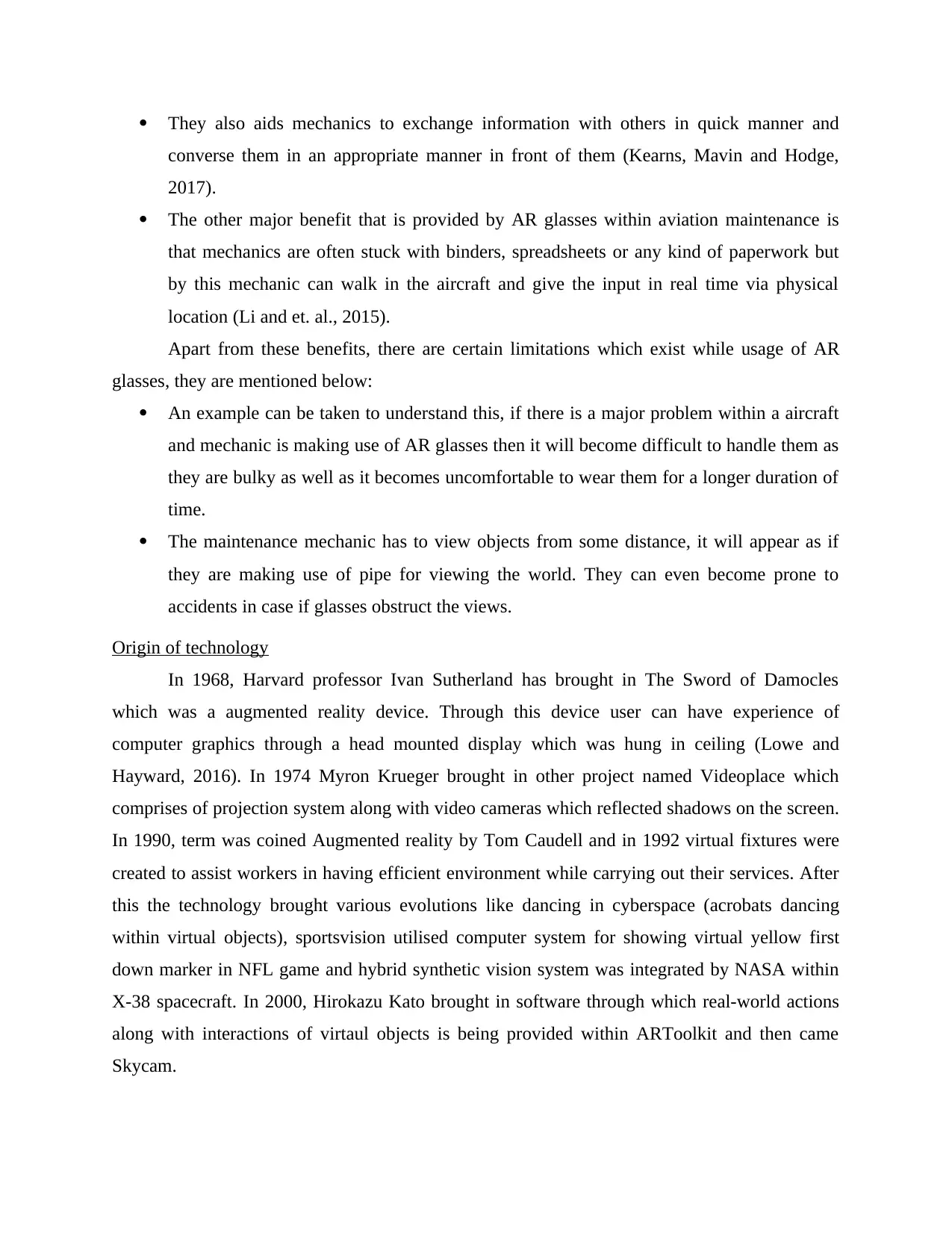
They also aids mechanics to exchange information with others in quick manner and
converse them in an appropriate manner in front of them (Kearns, Mavin and Hodge,
2017).
The other major benefit that is provided by AR glasses within aviation maintenance is
that mechanics are often stuck with binders, spreadsheets or any kind of paperwork but
by this mechanic can walk in the aircraft and give the input in real time via physical
location (Li and et. al., 2015).
Apart from these benefits, there are certain limitations which exist while usage of AR
glasses, they are mentioned below:
An example can be taken to understand this, if there is a major problem within a aircraft
and mechanic is making use of AR glasses then it will become difficult to handle them as
they are bulky as well as it becomes uncomfortable to wear them for a longer duration of
time.
The maintenance mechanic has to view objects from some distance, it will appear as if
they are making use of pipe for viewing the world. They can even become prone to
accidents in case if glasses obstruct the views.
Origin of technology
In 1968, Harvard professor Ivan Sutherland has brought in The Sword of Damocles
which was a augmented reality device. Through this device user can have experience of
computer graphics through a head mounted display which was hung in ceiling (Lowe and
Hayward, 2016). In 1974 Myron Krueger brought in other project named Videoplace which
comprises of projection system along with video cameras which reflected shadows on the screen.
In 1990, term was coined Augmented reality by Tom Caudell and in 1992 virtual fixtures were
created to assist workers in having efficient environment while carrying out their services. After
this the technology brought various evolutions like dancing in cyberspace (acrobats dancing
within virtual objects), sportsvision utilised computer system for showing virtual yellow first
down marker in NFL game and hybrid synthetic vision system was integrated by NASA within
X-38 spacecraft. In 2000, Hirokazu Kato brought in software through which real-world actions
along with interactions of virtaul objects is being provided within ARToolkit and then came
Skycam.
converse them in an appropriate manner in front of them (Kearns, Mavin and Hodge,
2017).
The other major benefit that is provided by AR glasses within aviation maintenance is
that mechanics are often stuck with binders, spreadsheets or any kind of paperwork but
by this mechanic can walk in the aircraft and give the input in real time via physical
location (Li and et. al., 2015).
Apart from these benefits, there are certain limitations which exist while usage of AR
glasses, they are mentioned below:
An example can be taken to understand this, if there is a major problem within a aircraft
and mechanic is making use of AR glasses then it will become difficult to handle them as
they are bulky as well as it becomes uncomfortable to wear them for a longer duration of
time.
The maintenance mechanic has to view objects from some distance, it will appear as if
they are making use of pipe for viewing the world. They can even become prone to
accidents in case if glasses obstruct the views.
Origin of technology
In 1968, Harvard professor Ivan Sutherland has brought in The Sword of Damocles
which was a augmented reality device. Through this device user can have experience of
computer graphics through a head mounted display which was hung in ceiling (Lowe and
Hayward, 2016). In 1974 Myron Krueger brought in other project named Videoplace which
comprises of projection system along with video cameras which reflected shadows on the screen.
In 1990, term was coined Augmented reality by Tom Caudell and in 1992 virtual fixtures were
created to assist workers in having efficient environment while carrying out their services. After
this the technology brought various evolutions like dancing in cyberspace (acrobats dancing
within virtual objects), sportsvision utilised computer system for showing virtual yellow first
down marker in NFL game and hybrid synthetic vision system was integrated by NASA within
X-38 spacecraft. In 2000, Hirokazu Kato brought in software through which real-world actions
along with interactions of virtaul objects is being provided within ARToolkit and then came
Skycam.
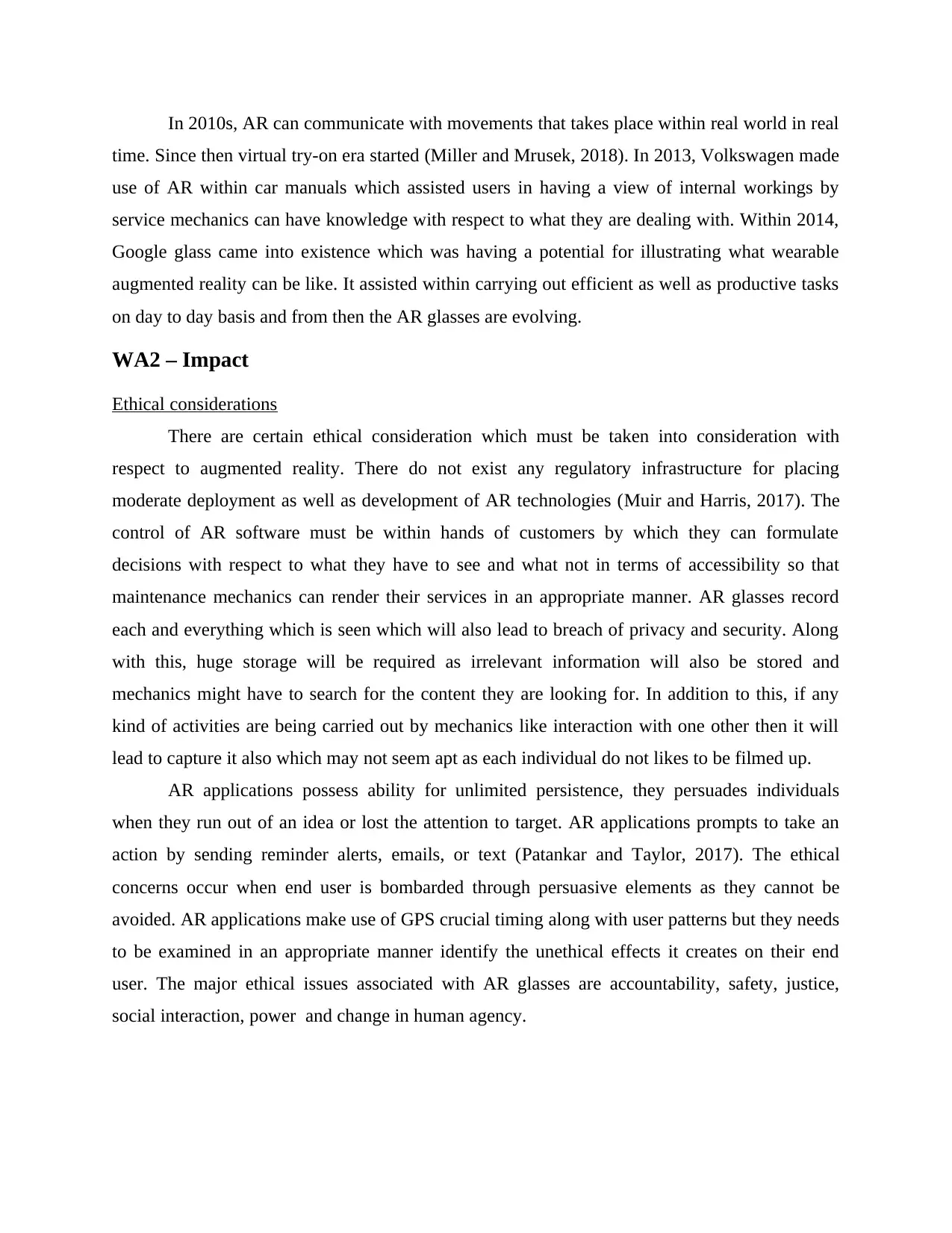
In 2010s, AR can communicate with movements that takes place within real world in real
time. Since then virtual try-on era started (Miller and Mrusek, 2018). In 2013, Volkswagen made
use of AR within car manuals which assisted users in having a view of internal workings by
service mechanics can have knowledge with respect to what they are dealing with. Within 2014,
Google glass came into existence which was having a potential for illustrating what wearable
augmented reality can be like. It assisted within carrying out efficient as well as productive tasks
on day to day basis and from then the AR glasses are evolving.
WA2 – Impact
Ethical considerations
There are certain ethical consideration which must be taken into consideration with
respect to augmented reality. There do not exist any regulatory infrastructure for placing
moderate deployment as well as development of AR technologies (Muir and Harris, 2017). The
control of AR software must be within hands of customers by which they can formulate
decisions with respect to what they have to see and what not in terms of accessibility so that
maintenance mechanics can render their services in an appropriate manner. AR glasses record
each and everything which is seen which will also lead to breach of privacy and security. Along
with this, huge storage will be required as irrelevant information will also be stored and
mechanics might have to search for the content they are looking for. In addition to this, if any
kind of activities are being carried out by mechanics like interaction with one other then it will
lead to capture it also which may not seem apt as each individual do not likes to be filmed up.
AR applications possess ability for unlimited persistence, they persuades individuals
when they run out of an idea or lost the attention to target. AR applications prompts to take an
action by sending reminder alerts, emails, or text (Patankar and Taylor, 2017). The ethical
concerns occur when end user is bombarded through persuasive elements as they cannot be
avoided. AR applications make use of GPS crucial timing along with user patterns but they needs
to be examined in an appropriate manner identify the unethical effects it creates on their end
user. The major ethical issues associated with AR glasses are accountability, safety, justice,
social interaction, power and change in human agency.
time. Since then virtual try-on era started (Miller and Mrusek, 2018). In 2013, Volkswagen made
use of AR within car manuals which assisted users in having a view of internal workings by
service mechanics can have knowledge with respect to what they are dealing with. Within 2014,
Google glass came into existence which was having a potential for illustrating what wearable
augmented reality can be like. It assisted within carrying out efficient as well as productive tasks
on day to day basis and from then the AR glasses are evolving.
WA2 – Impact
Ethical considerations
There are certain ethical consideration which must be taken into consideration with
respect to augmented reality. There do not exist any regulatory infrastructure for placing
moderate deployment as well as development of AR technologies (Muir and Harris, 2017). The
control of AR software must be within hands of customers by which they can formulate
decisions with respect to what they have to see and what not in terms of accessibility so that
maintenance mechanics can render their services in an appropriate manner. AR glasses record
each and everything which is seen which will also lead to breach of privacy and security. Along
with this, huge storage will be required as irrelevant information will also be stored and
mechanics might have to search for the content they are looking for. In addition to this, if any
kind of activities are being carried out by mechanics like interaction with one other then it will
lead to capture it also which may not seem apt as each individual do not likes to be filmed up.
AR applications possess ability for unlimited persistence, they persuades individuals
when they run out of an idea or lost the attention to target. AR applications prompts to take an
action by sending reminder alerts, emails, or text (Patankar and Taylor, 2017). The ethical
concerns occur when end user is bombarded through persuasive elements as they cannot be
avoided. AR applications make use of GPS crucial timing along with user patterns but they needs
to be examined in an appropriate manner identify the unethical effects it creates on their end
user. The major ethical issues associated with AR glasses are accountability, safety, justice,
social interaction, power and change in human agency.
⊘ This is a preview!⊘
Do you want full access?
Subscribe today to unlock all pages.

Trusted by 1+ million students worldwide
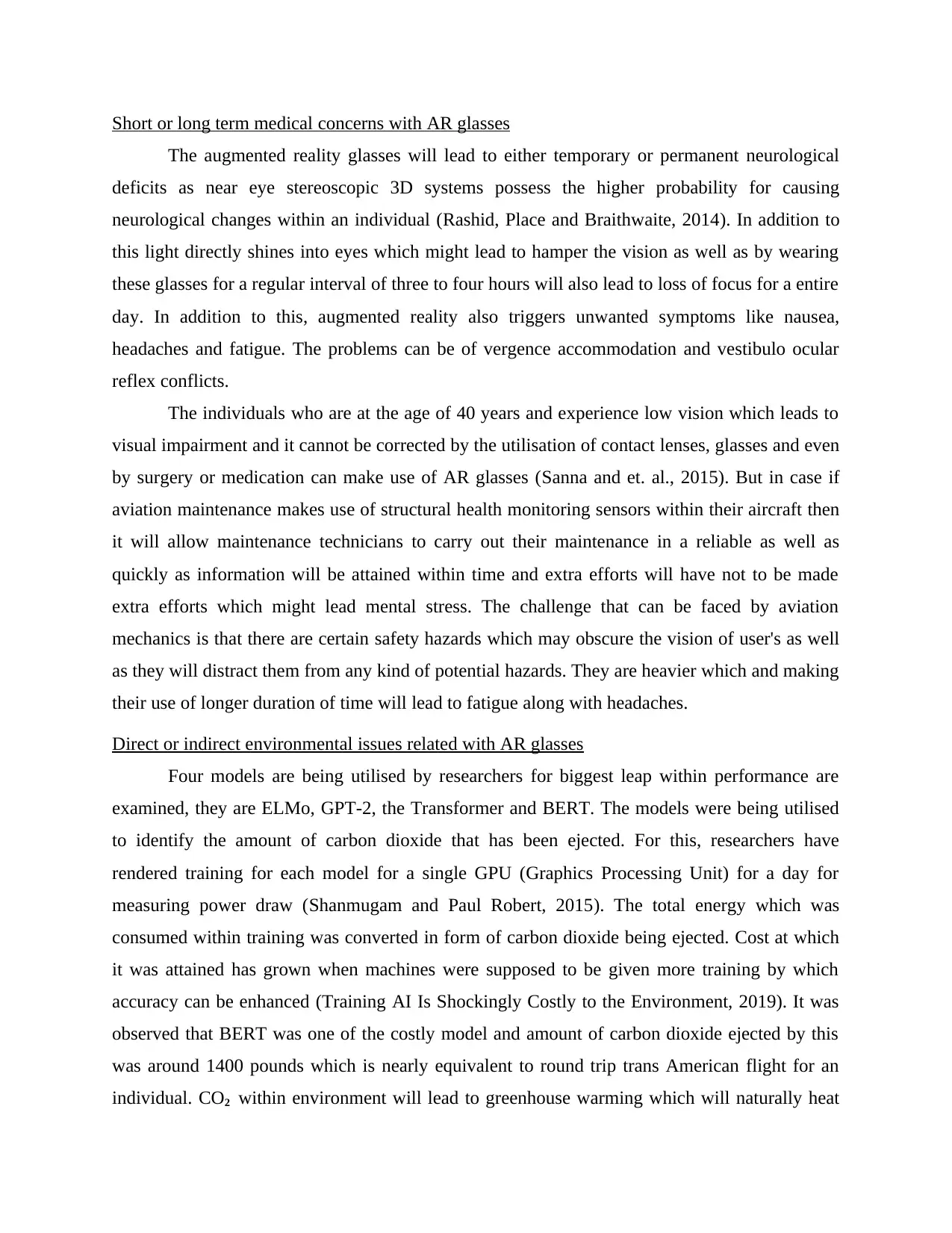
Short or long term medical concerns with AR glasses
The augmented reality glasses will lead to either temporary or permanent neurological
deficits as near eye stereoscopic 3D systems possess the higher probability for causing
neurological changes within an individual (Rashid, Place and Braithwaite, 2014). In addition to
this light directly shines into eyes which might lead to hamper the vision as well as by wearing
these glasses for a regular interval of three to four hours will also lead to loss of focus for a entire
day. In addition to this, augmented reality also triggers unwanted symptoms like nausea,
headaches and fatigue. The problems can be of vergence accommodation and vestibulo ocular
reflex conflicts.
The individuals who are at the age of 40 years and experience low vision which leads to
visual impairment and it cannot be corrected by the utilisation of contact lenses, glasses and even
by surgery or medication can make use of AR glasses (Sanna and et. al., 2015). But in case if
aviation maintenance makes use of structural health monitoring sensors within their aircraft then
it will allow maintenance technicians to carry out their maintenance in a reliable as well as
quickly as information will be attained within time and extra efforts will have not to be made
extra efforts which might lead mental stress. The challenge that can be faced by aviation
mechanics is that there are certain safety hazards which may obscure the vision of user's as well
as they will distract them from any kind of potential hazards. They are heavier which and making
their use of longer duration of time will lead to fatigue along with headaches.
Direct or indirect environmental issues related with AR glasses
Four models are being utilised by researchers for biggest leap within performance are
examined, they are ELMo, GPT-2, the Transformer and BERT. The models were being utilised
to identify the amount of carbon dioxide that has been ejected. For this, researchers have
rendered training for each model for a single GPU (Graphics Processing Unit) for a day for
measuring power draw (Shanmugam and Paul Robert, 2015). The total energy which was
consumed within training was converted in form of carbon dioxide being ejected. Cost at which
it was attained has grown when machines were supposed to be given more training by which
accuracy can be enhanced (Training AI Is Shockingly Costly to the Environment, 2019). It was
observed that BERT was one of the costly model and amount of carbon dioxide ejected by this
was around 1400 pounds which is nearly equivalent to round trip trans American flight for an
individual. CO2 within environment will lead to greenhouse warming which will naturally heat
The augmented reality glasses will lead to either temporary or permanent neurological
deficits as near eye stereoscopic 3D systems possess the higher probability for causing
neurological changes within an individual (Rashid, Place and Braithwaite, 2014). In addition to
this light directly shines into eyes which might lead to hamper the vision as well as by wearing
these glasses for a regular interval of three to four hours will also lead to loss of focus for a entire
day. In addition to this, augmented reality also triggers unwanted symptoms like nausea,
headaches and fatigue. The problems can be of vergence accommodation and vestibulo ocular
reflex conflicts.
The individuals who are at the age of 40 years and experience low vision which leads to
visual impairment and it cannot be corrected by the utilisation of contact lenses, glasses and even
by surgery or medication can make use of AR glasses (Sanna and et. al., 2015). But in case if
aviation maintenance makes use of structural health monitoring sensors within their aircraft then
it will allow maintenance technicians to carry out their maintenance in a reliable as well as
quickly as information will be attained within time and extra efforts will have not to be made
extra efforts which might lead mental stress. The challenge that can be faced by aviation
mechanics is that there are certain safety hazards which may obscure the vision of user's as well
as they will distract them from any kind of potential hazards. They are heavier which and making
their use of longer duration of time will lead to fatigue along with headaches.
Direct or indirect environmental issues related with AR glasses
Four models are being utilised by researchers for biggest leap within performance are
examined, they are ELMo, GPT-2, the Transformer and BERT. The models were being utilised
to identify the amount of carbon dioxide that has been ejected. For this, researchers have
rendered training for each model for a single GPU (Graphics Processing Unit) for a day for
measuring power draw (Shanmugam and Paul Robert, 2015). The total energy which was
consumed within training was converted in form of carbon dioxide being ejected. Cost at which
it was attained has grown when machines were supposed to be given more training by which
accuracy can be enhanced (Training AI Is Shockingly Costly to the Environment, 2019). It was
observed that BERT was one of the costly model and amount of carbon dioxide ejected by this
was around 1400 pounds which is nearly equivalent to round trip trans American flight for an
individual. CO2 within environment will lead to greenhouse warming which will naturally heat
Paraphrase This Document
Need a fresh take? Get an instant paraphrase of this document with our AI Paraphraser
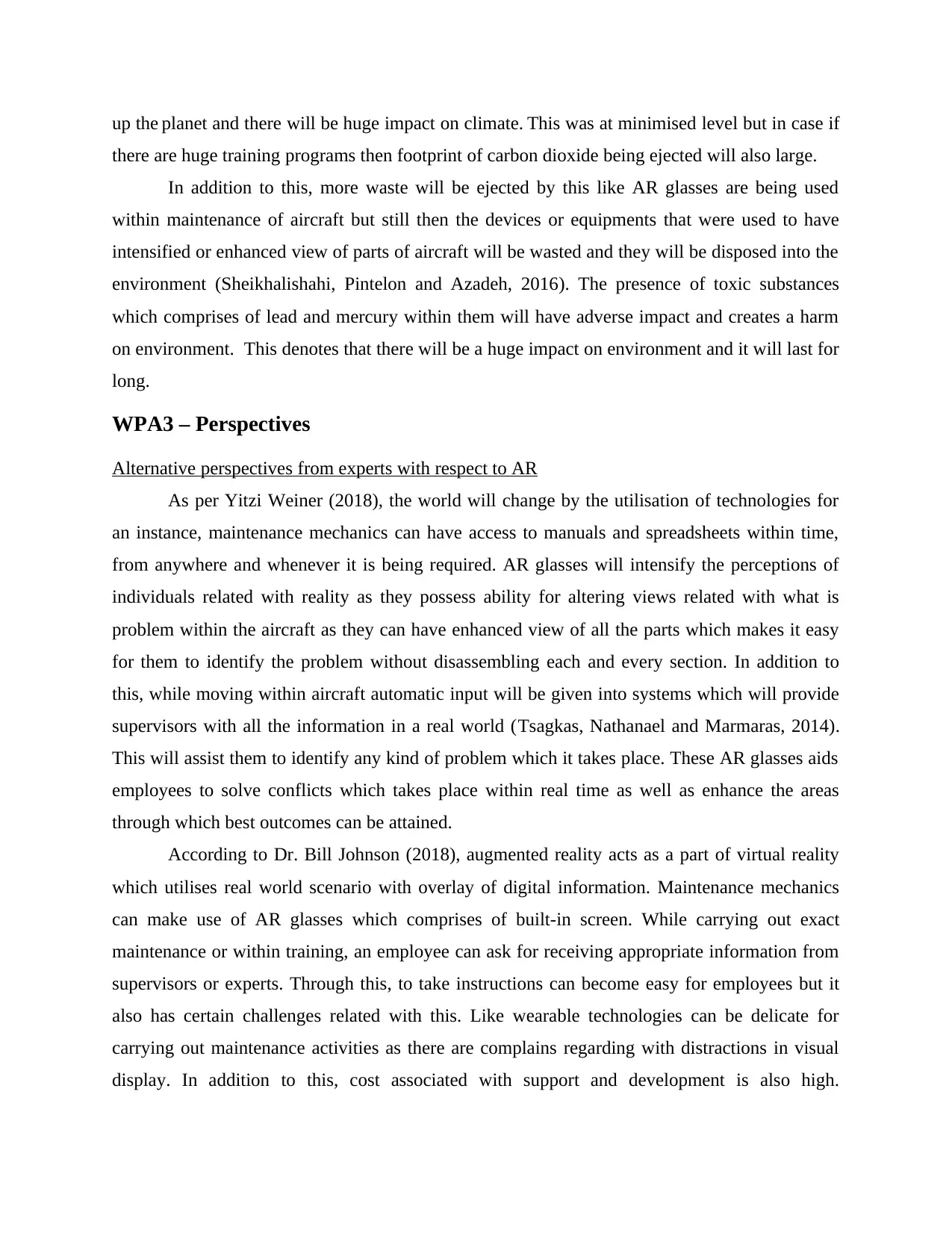
up the planet and there will be huge impact on climate. This was at minimised level but in case if
there are huge training programs then footprint of carbon dioxide being ejected will also large.
In addition to this, more waste will be ejected by this like AR glasses are being used
within maintenance of aircraft but still then the devices or equipments that were used to have
intensified or enhanced view of parts of aircraft will be wasted and they will be disposed into the
environment (Sheikhalishahi, Pintelon and Azadeh, 2016). The presence of toxic substances
which comprises of lead and mercury within them will have adverse impact and creates a harm
on environment. This denotes that there will be a huge impact on environment and it will last for
long.
WPA3 – Perspectives
Alternative perspectives from experts with respect to AR
As per Yitzi Weiner (2018), the world will change by the utilisation of technologies for
an instance, maintenance mechanics can have access to manuals and spreadsheets within time,
from anywhere and whenever it is being required. AR glasses will intensify the perceptions of
individuals related with reality as they possess ability for altering views related with what is
problem within the aircraft as they can have enhanced view of all the parts which makes it easy
for them to identify the problem without disassembling each and every section. In addition to
this, while moving within aircraft automatic input will be given into systems which will provide
supervisors with all the information in a real world (Tsagkas, Nathanael and Marmaras, 2014).
This will assist them to identify any kind of problem which it takes place. These AR glasses aids
employees to solve conflicts which takes place within real time as well as enhance the areas
through which best outcomes can be attained.
According to Dr. Bill Johnson (2018), augmented reality acts as a part of virtual reality
which utilises real world scenario with overlay of digital information. Maintenance mechanics
can make use of AR glasses which comprises of built-in screen. While carrying out exact
maintenance or within training, an employee can ask for receiving appropriate information from
supervisors or experts. Through this, to take instructions can become easy for employees but it
also has certain challenges related with this. Like wearable technologies can be delicate for
carrying out maintenance activities as there are complains regarding with distractions in visual
display. In addition to this, cost associated with support and development is also high.
there are huge training programs then footprint of carbon dioxide being ejected will also large.
In addition to this, more waste will be ejected by this like AR glasses are being used
within maintenance of aircraft but still then the devices or equipments that were used to have
intensified or enhanced view of parts of aircraft will be wasted and they will be disposed into the
environment (Sheikhalishahi, Pintelon and Azadeh, 2016). The presence of toxic substances
which comprises of lead and mercury within them will have adverse impact and creates a harm
on environment. This denotes that there will be a huge impact on environment and it will last for
long.
WPA3 – Perspectives
Alternative perspectives from experts with respect to AR
As per Yitzi Weiner (2018), the world will change by the utilisation of technologies for
an instance, maintenance mechanics can have access to manuals and spreadsheets within time,
from anywhere and whenever it is being required. AR glasses will intensify the perceptions of
individuals related with reality as they possess ability for altering views related with what is
problem within the aircraft as they can have enhanced view of all the parts which makes it easy
for them to identify the problem without disassembling each and every section. In addition to
this, while moving within aircraft automatic input will be given into systems which will provide
supervisors with all the information in a real world (Tsagkas, Nathanael and Marmaras, 2014).
This will assist them to identify any kind of problem which it takes place. These AR glasses aids
employees to solve conflicts which takes place within real time as well as enhance the areas
through which best outcomes can be attained.
According to Dr. Bill Johnson (2018), augmented reality acts as a part of virtual reality
which utilises real world scenario with overlay of digital information. Maintenance mechanics
can make use of AR glasses which comprises of built-in screen. While carrying out exact
maintenance or within training, an employee can ask for receiving appropriate information from
supervisors or experts. Through this, to take instructions can become easy for employees but it
also has certain challenges related with this. Like wearable technologies can be delicate for
carrying out maintenance activities as there are complains regarding with distractions in visual
display. In addition to this, cost associated with support and development is also high.
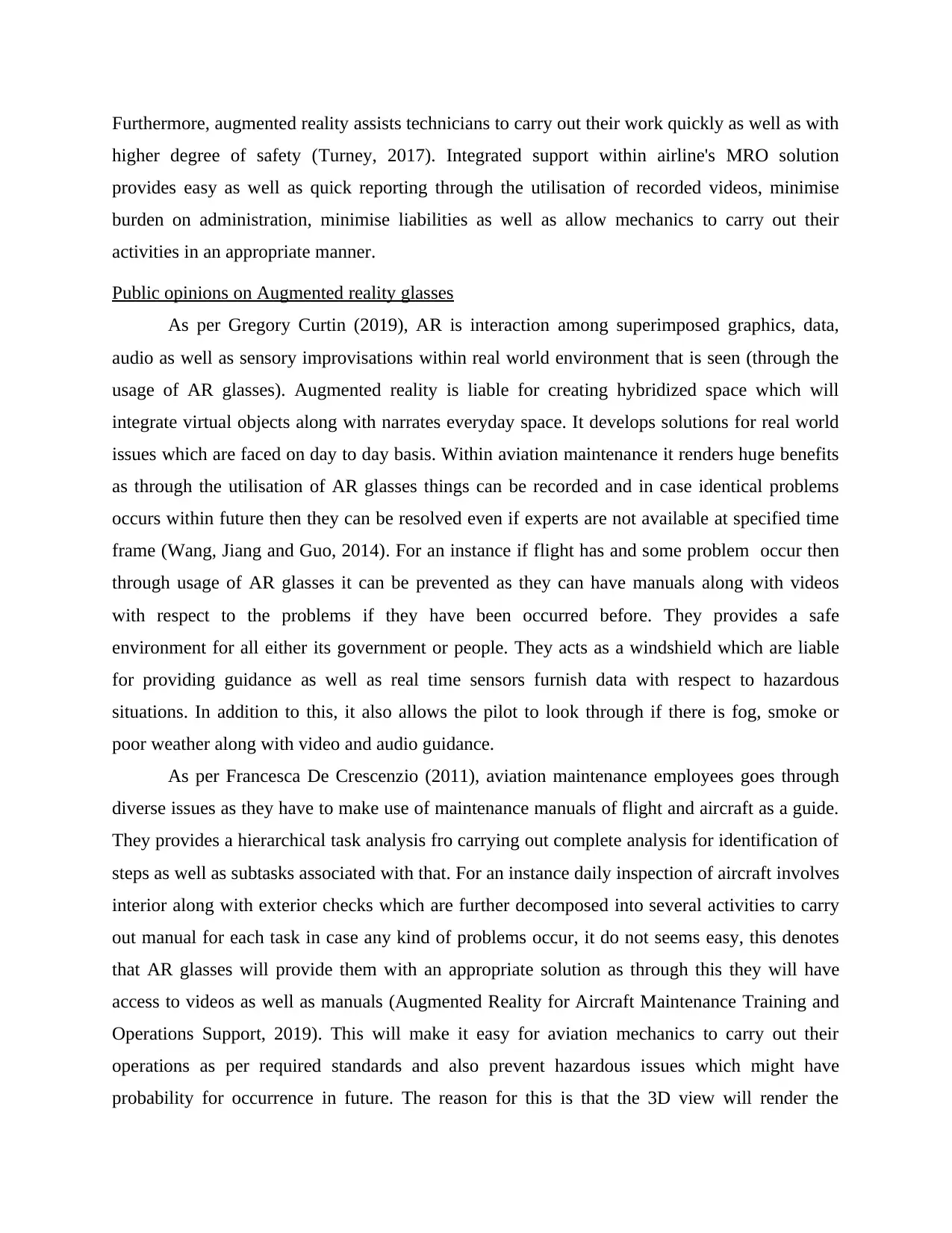
Furthermore, augmented reality assists technicians to carry out their work quickly as well as with
higher degree of safety (Turney, 2017). Integrated support within airline's MRO solution
provides easy as well as quick reporting through the utilisation of recorded videos, minimise
burden on administration, minimise liabilities as well as allow mechanics to carry out their
activities in an appropriate manner.
Public opinions on Augmented reality glasses
As per Gregory Curtin (2019), AR is interaction among superimposed graphics, data,
audio as well as sensory improvisations within real world environment that is seen (through the
usage of AR glasses). Augmented reality is liable for creating hybridized space which will
integrate virtual objects along with narrates everyday space. It develops solutions for real world
issues which are faced on day to day basis. Within aviation maintenance it renders huge benefits
as through the utilisation of AR glasses things can be recorded and in case identical problems
occurs within future then they can be resolved even if experts are not available at specified time
frame (Wang, Jiang and Guo, 2014). For an instance if flight has and some problem occur then
through usage of AR glasses it can be prevented as they can have manuals along with videos
with respect to the problems if they have been occurred before. They provides a safe
environment for all either its government or people. They acts as a windshield which are liable
for providing guidance as well as real time sensors furnish data with respect to hazardous
situations. In addition to this, it also allows the pilot to look through if there is fog, smoke or
poor weather along with video and audio guidance.
As per Francesca De Crescenzio (2011), aviation maintenance employees goes through
diverse issues as they have to make use of maintenance manuals of flight and aircraft as a guide.
They provides a hierarchical task analysis fro carrying out complete analysis for identification of
steps as well as subtasks associated with that. For an instance daily inspection of aircraft involves
interior along with exterior checks which are further decomposed into several activities to carry
out manual for each task in case any kind of problems occur, it do not seems easy, this denotes
that AR glasses will provide them with an appropriate solution as through this they will have
access to videos as well as manuals (Augmented Reality for Aircraft Maintenance Training and
Operations Support, 2019). This will make it easy for aviation mechanics to carry out their
operations as per required standards and also prevent hazardous issues which might have
probability for occurrence in future. The reason for this is that the 3D view will render the
higher degree of safety (Turney, 2017). Integrated support within airline's MRO solution
provides easy as well as quick reporting through the utilisation of recorded videos, minimise
burden on administration, minimise liabilities as well as allow mechanics to carry out their
activities in an appropriate manner.
Public opinions on Augmented reality glasses
As per Gregory Curtin (2019), AR is interaction among superimposed graphics, data,
audio as well as sensory improvisations within real world environment that is seen (through the
usage of AR glasses). Augmented reality is liable for creating hybridized space which will
integrate virtual objects along with narrates everyday space. It develops solutions for real world
issues which are faced on day to day basis. Within aviation maintenance it renders huge benefits
as through the utilisation of AR glasses things can be recorded and in case identical problems
occurs within future then they can be resolved even if experts are not available at specified time
frame (Wang, Jiang and Guo, 2014). For an instance if flight has and some problem occur then
through usage of AR glasses it can be prevented as they can have manuals along with videos
with respect to the problems if they have been occurred before. They provides a safe
environment for all either its government or people. They acts as a windshield which are liable
for providing guidance as well as real time sensors furnish data with respect to hazardous
situations. In addition to this, it also allows the pilot to look through if there is fog, smoke or
poor weather along with video and audio guidance.
As per Francesca De Crescenzio (2011), aviation maintenance employees goes through
diverse issues as they have to make use of maintenance manuals of flight and aircraft as a guide.
They provides a hierarchical task analysis fro carrying out complete analysis for identification of
steps as well as subtasks associated with that. For an instance daily inspection of aircraft involves
interior along with exterior checks which are further decomposed into several activities to carry
out manual for each task in case any kind of problems occur, it do not seems easy, this denotes
that AR glasses will provide them with an appropriate solution as through this they will have
access to videos as well as manuals (Augmented Reality for Aircraft Maintenance Training and
Operations Support, 2019). This will make it easy for aviation mechanics to carry out their
operations as per required standards and also prevent hazardous issues which might have
probability for occurrence in future. The reason for this is that the 3D view will render the
⊘ This is a preview!⊘
Do you want full access?
Subscribe today to unlock all pages.

Trusted by 1+ million students worldwide
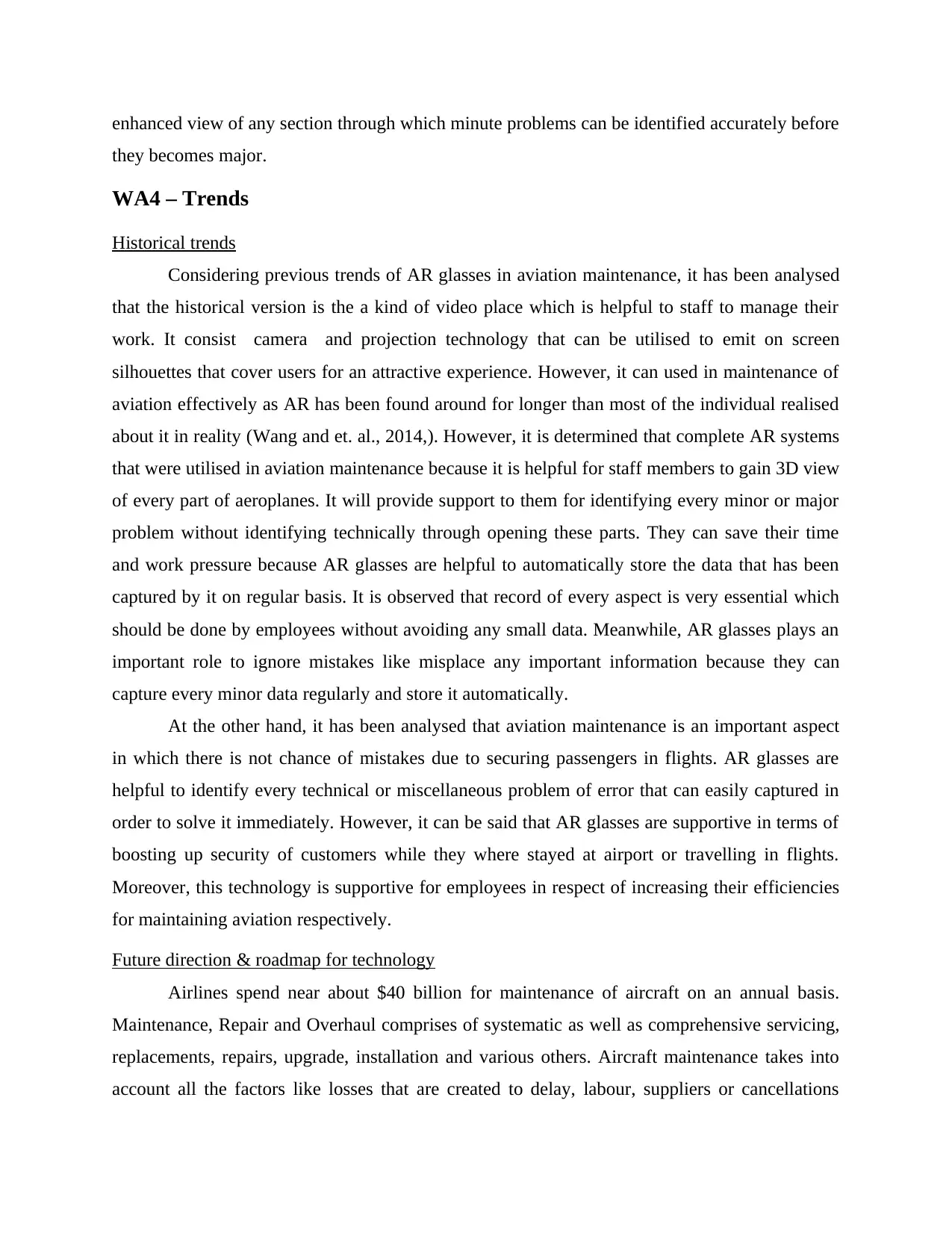
enhanced view of any section through which minute problems can be identified accurately before
they becomes major.
WA4 – Trends
Historical trends
Considering previous trends of AR glasses in aviation maintenance, it has been analysed
that the historical version is the a kind of video place which is helpful to staff to manage their
work. It consist camera and projection technology that can be utilised to emit on screen
silhouettes that cover users for an attractive experience. However, it can used in maintenance of
aviation effectively as AR has been found around for longer than most of the individual realised
about it in reality (Wang and et. al., 2014,). However, it is determined that complete AR systems
that were utilised in aviation maintenance because it is helpful for staff members to gain 3D view
of every part of aeroplanes. It will provide support to them for identifying every minor or major
problem without identifying technically through opening these parts. They can save their time
and work pressure because AR glasses are helpful to automatically store the data that has been
captured by it on regular basis. It is observed that record of every aspect is very essential which
should be done by employees without avoiding any small data. Meanwhile, AR glasses plays an
important role to ignore mistakes like misplace any important information because they can
capture every minor data regularly and store it automatically.
At the other hand, it has been analysed that aviation maintenance is an important aspect
in which there is not chance of mistakes due to securing passengers in flights. AR glasses are
helpful to identify every technical or miscellaneous problem of error that can easily captured in
order to solve it immediately. However, it can be said that AR glasses are supportive in terms of
boosting up security of customers while they where stayed at airport or travelling in flights.
Moreover, this technology is supportive for employees in respect of increasing their efficiencies
for maintaining aviation respectively.
Future direction & roadmap for technology
Airlines spend near about $40 billion for maintenance of aircraft on an annual basis.
Maintenance, Repair and Overhaul comprises of systematic as well as comprehensive servicing,
replacements, repairs, upgrade, installation and various others. Aircraft maintenance takes into
account all the factors like losses that are created to delay, labour, suppliers or cancellations
they becomes major.
WA4 – Trends
Historical trends
Considering previous trends of AR glasses in aviation maintenance, it has been analysed
that the historical version is the a kind of video place which is helpful to staff to manage their
work. It consist camera and projection technology that can be utilised to emit on screen
silhouettes that cover users for an attractive experience. However, it can used in maintenance of
aviation effectively as AR has been found around for longer than most of the individual realised
about it in reality (Wang and et. al., 2014,). However, it is determined that complete AR systems
that were utilised in aviation maintenance because it is helpful for staff members to gain 3D view
of every part of aeroplanes. It will provide support to them for identifying every minor or major
problem without identifying technically through opening these parts. They can save their time
and work pressure because AR glasses are helpful to automatically store the data that has been
captured by it on regular basis. It is observed that record of every aspect is very essential which
should be done by employees without avoiding any small data. Meanwhile, AR glasses plays an
important role to ignore mistakes like misplace any important information because they can
capture every minor data regularly and store it automatically.
At the other hand, it has been analysed that aviation maintenance is an important aspect
in which there is not chance of mistakes due to securing passengers in flights. AR glasses are
helpful to identify every technical or miscellaneous problem of error that can easily captured in
order to solve it immediately. However, it can be said that AR glasses are supportive in terms of
boosting up security of customers while they where stayed at airport or travelling in flights.
Moreover, this technology is supportive for employees in respect of increasing their efficiencies
for maintaining aviation respectively.
Future direction & roadmap for technology
Airlines spend near about $40 billion for maintenance of aircraft on an annual basis.
Maintenance, Repair and Overhaul comprises of systematic as well as comprehensive servicing,
replacements, repairs, upgrade, installation and various others. Aircraft maintenance takes into
account all the factors like losses that are created to delay, labour, suppliers or cancellations
Paraphrase This Document
Need a fresh take? Get an instant paraphrase of this document with our AI Paraphraser
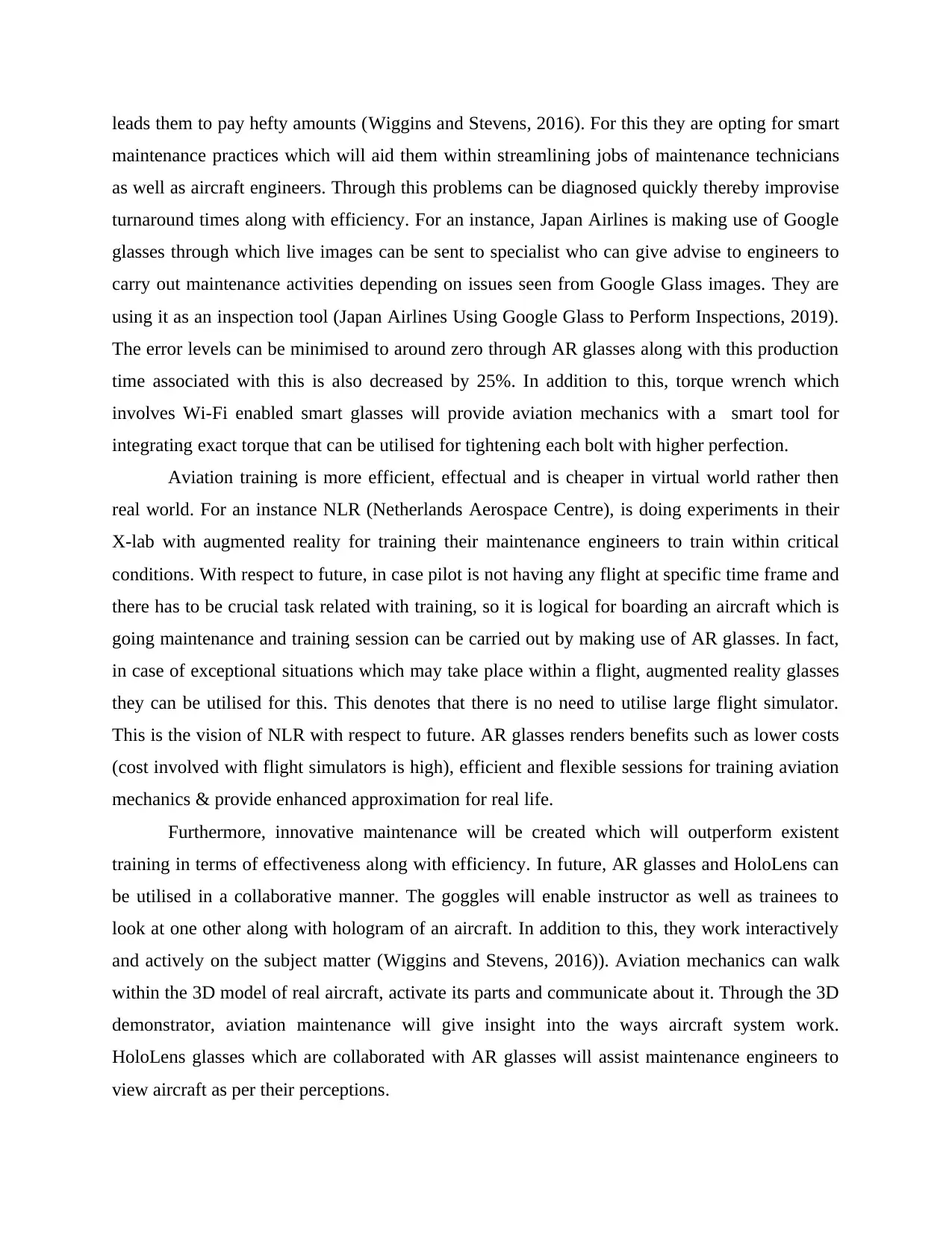
leads them to pay hefty amounts (Wiggins and Stevens, 2016). For this they are opting for smart
maintenance practices which will aid them within streamlining jobs of maintenance technicians
as well as aircraft engineers. Through this problems can be diagnosed quickly thereby improvise
turnaround times along with efficiency. For an instance, Japan Airlines is making use of Google
glasses through which live images can be sent to specialist who can give advise to engineers to
carry out maintenance activities depending on issues seen from Google Glass images. They are
using it as an inspection tool (Japan Airlines Using Google Glass to Perform Inspections, 2019).
The error levels can be minimised to around zero through AR glasses along with this production
time associated with this is also decreased by 25%. In addition to this, torque wrench which
involves Wi-Fi enabled smart glasses will provide aviation mechanics with a smart tool for
integrating exact torque that can be utilised for tightening each bolt with higher perfection.
Aviation training is more efficient, effectual and is cheaper in virtual world rather then
real world. For an instance NLR (Netherlands Aerospace Centre), is doing experiments in their
X-lab with augmented reality for training their maintenance engineers to train within critical
conditions. With respect to future, in case pilot is not having any flight at specific time frame and
there has to be crucial task related with training, so it is logical for boarding an aircraft which is
going maintenance and training session can be carried out by making use of AR glasses. In fact,
in case of exceptional situations which may take place within a flight, augmented reality glasses
they can be utilised for this. This denotes that there is no need to utilise large flight simulator.
This is the vision of NLR with respect to future. AR glasses renders benefits such as lower costs
(cost involved with flight simulators is high), efficient and flexible sessions for training aviation
mechanics & provide enhanced approximation for real life.
Furthermore, innovative maintenance will be created which will outperform existent
training in terms of effectiveness along with efficiency. In future, AR glasses and HoloLens can
be utilised in a collaborative manner. The goggles will enable instructor as well as trainees to
look at one other along with hologram of an aircraft. In addition to this, they work interactively
and actively on the subject matter (Wiggins and Stevens, 2016)). Aviation mechanics can walk
within the 3D model of real aircraft, activate its parts and communicate about it. Through the 3D
demonstrator, aviation maintenance will give insight into the ways aircraft system work.
HoloLens glasses which are collaborated with AR glasses will assist maintenance engineers to
view aircraft as per their perceptions.
maintenance practices which will aid them within streamlining jobs of maintenance technicians
as well as aircraft engineers. Through this problems can be diagnosed quickly thereby improvise
turnaround times along with efficiency. For an instance, Japan Airlines is making use of Google
glasses through which live images can be sent to specialist who can give advise to engineers to
carry out maintenance activities depending on issues seen from Google Glass images. They are
using it as an inspection tool (Japan Airlines Using Google Glass to Perform Inspections, 2019).
The error levels can be minimised to around zero through AR glasses along with this production
time associated with this is also decreased by 25%. In addition to this, torque wrench which
involves Wi-Fi enabled smart glasses will provide aviation mechanics with a smart tool for
integrating exact torque that can be utilised for tightening each bolt with higher perfection.
Aviation training is more efficient, effectual and is cheaper in virtual world rather then
real world. For an instance NLR (Netherlands Aerospace Centre), is doing experiments in their
X-lab with augmented reality for training their maintenance engineers to train within critical
conditions. With respect to future, in case pilot is not having any flight at specific time frame and
there has to be crucial task related with training, so it is logical for boarding an aircraft which is
going maintenance and training session can be carried out by making use of AR glasses. In fact,
in case of exceptional situations which may take place within a flight, augmented reality glasses
they can be utilised for this. This denotes that there is no need to utilise large flight simulator.
This is the vision of NLR with respect to future. AR glasses renders benefits such as lower costs
(cost involved with flight simulators is high), efficient and flexible sessions for training aviation
mechanics & provide enhanced approximation for real life.
Furthermore, innovative maintenance will be created which will outperform existent
training in terms of effectiveness along with efficiency. In future, AR glasses and HoloLens can
be utilised in a collaborative manner. The goggles will enable instructor as well as trainees to
look at one other along with hologram of an aircraft. In addition to this, they work interactively
and actively on the subject matter (Wiggins and Stevens, 2016)). Aviation mechanics can walk
within the 3D model of real aircraft, activate its parts and communicate about it. Through the 3D
demonstrator, aviation maintenance will give insight into the ways aircraft system work.
HoloLens glasses which are collaborated with AR glasses will assist maintenance engineers to
view aircraft as per their perceptions.
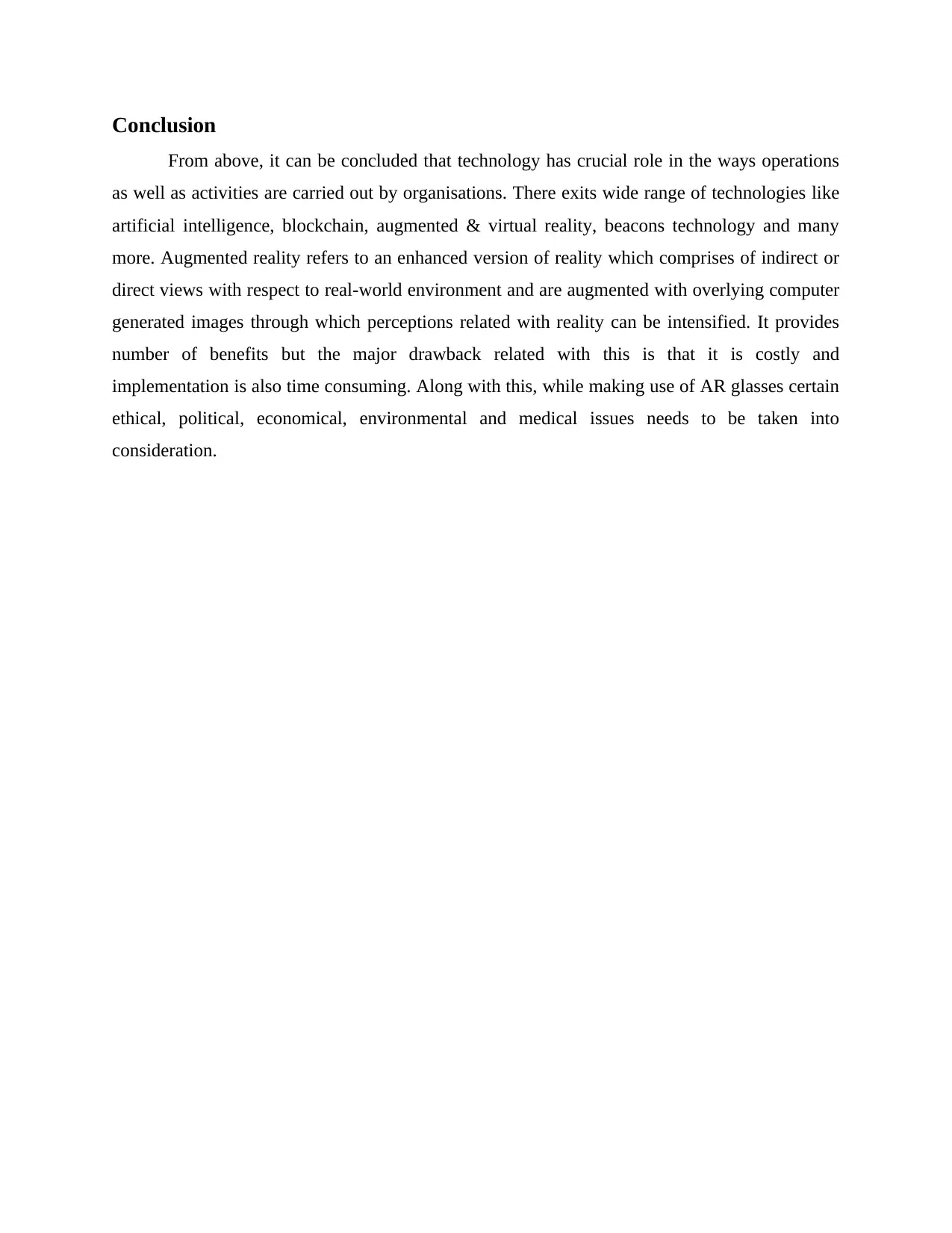
Conclusion
From above, it can be concluded that technology has crucial role in the ways operations
as well as activities are carried out by organisations. There exits wide range of technologies like
artificial intelligence, blockchain, augmented & virtual reality, beacons technology and many
more. Augmented reality refers to an enhanced version of reality which comprises of indirect or
direct views with respect to real-world environment and are augmented with overlying computer
generated images through which perceptions related with reality can be intensified. It provides
number of benefits but the major drawback related with this is that it is costly and
implementation is also time consuming. Along with this, while making use of AR glasses certain
ethical, political, economical, environmental and medical issues needs to be taken into
consideration.
From above, it can be concluded that technology has crucial role in the ways operations
as well as activities are carried out by organisations. There exits wide range of technologies like
artificial intelligence, blockchain, augmented & virtual reality, beacons technology and many
more. Augmented reality refers to an enhanced version of reality which comprises of indirect or
direct views with respect to real-world environment and are augmented with overlying computer
generated images through which perceptions related with reality can be intensified. It provides
number of benefits but the major drawback related with this is that it is costly and
implementation is also time consuming. Along with this, while making use of AR glasses certain
ethical, political, economical, environmental and medical issues needs to be taken into
consideration.
⊘ This is a preview!⊘
Do you want full access?
Subscribe today to unlock all pages.

Trusted by 1+ million students worldwide
1 out of 14
Related Documents
Your All-in-One AI-Powered Toolkit for Academic Success.
+13062052269
info@desklib.com
Available 24*7 on WhatsApp / Email
![[object Object]](/_next/static/media/star-bottom.7253800d.svg)
Unlock your academic potential
Copyright © 2020–2025 A2Z Services. All Rights Reserved. Developed and managed by ZUCOL.





